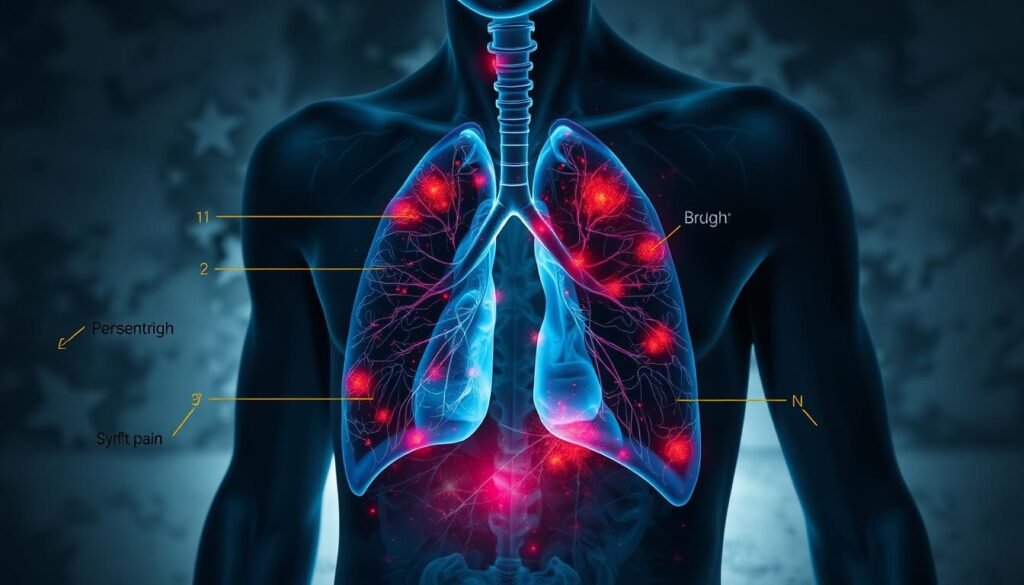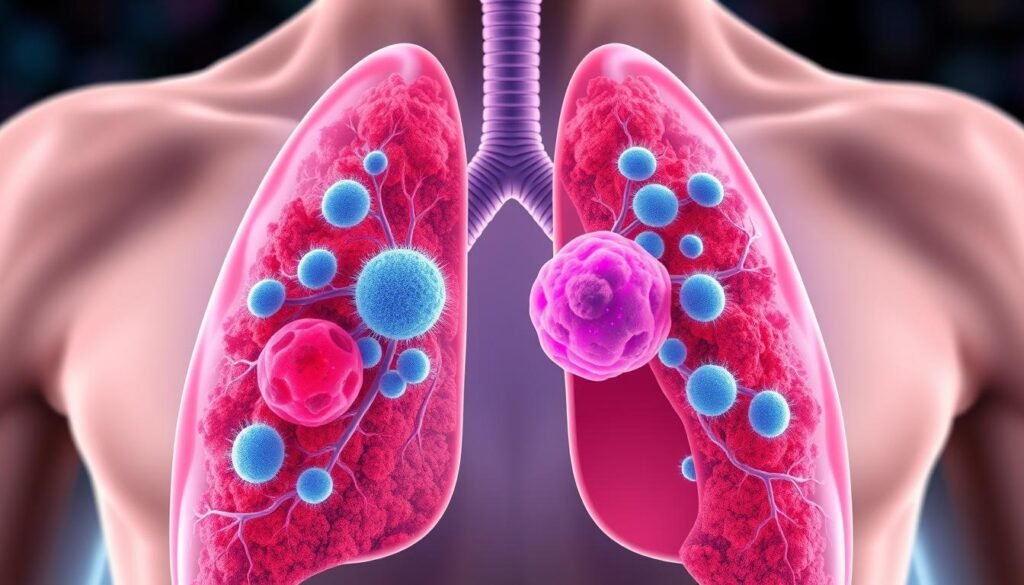About 30–40% of people with non-small cell lung cancer are diagnosed with metastatic lung cancer from the start. This fact highlights how complicated this disease is. It spreads from the lungs to other body parts. Treating metastatic lung cancer is more complex and changes the patient’s outlook greatly.
Lung cancer metastasis symptoms vary greatly and impact treatment and life quality. Ongoing chest pain, more coughing, and breathlessness can cause much discomfort and uncertainty. It’s crucial to understand metastatic lung cancer’s stages, symptoms, diagnosis, and treatment options available at lung cancer metastasis treatment. This knowledge helps patients and their families a lot.
Non-small cell lung cancer, the most common type, makes up about 85% of cases. Sadly, many patients find out they have cancer after it has spread. This makes palliative care and managing symptoms vital in their treatment plan. In this article, we’ll dive into metastatic lung cancer’s challenges and how to manage them.
Key Takeaways
- 30–40% of non-small cell lung cancer cases are diagnosed as metastatic.
- Common symptoms include coughing, chest pain, and shortness of breath.
- Palliative care is crucial for managing symptoms and improving quality of life.
- Understanding treatment options can help patients and families navigate this challenging journey.
- Collaborating with healthcare providers is key to effective care management.
What is Metastatic Lung Cancer?
Metastatic lung cancer starts in the lungs and spreads throughout the body. It’s also called advanced lung cancer. When it reaches the metastatic stage, the treatment becomes more challenging. Often, early-stage lung cancer has no symptoms and goes unnoticed.
About 30–40% of people with metastatic non-small cell lung cancer have already spread when diagnosed. It can move to lymph nodes, the brain, bones, liver, adrenal glands, or the other lung. The spread of cancer can cause different complications, depending on where it goes.
The main goals of treatment are to control the cancer, manage symptoms, and improve life quality. Sometimes, a cure isn’t possible. The news of an incurable disease brings significant emotional stress. Finding good information and support is key.
Knowing about the disease and treatment options helps patients cope. Talking with doctors helps them understand their situation better. They discuss survival chances and how the disease may progress, based on their case.
Common Symptoms of Lung Cancer Metastasis
Symptoms of lung cancer spreading vary widely. Persistent coughing is often an early alert. It may be joined by hemoptysis, or coughing up blood. This indicates severe issues. Shortness of breath also occurs. It makes simple tasks much harder.
Chest pain is another frequent symptom. This arises from cancer spread or fluid build-up around lungs. Unexplained weight loss is common as the body battles the illness. It can reduce appetite. Many also feel very tired as the illness progresses.
Spotting these symptoms early is crucial. Quick check-ups can lead to better care. If you have these symptoms, talk about them with experts, like those at RWJBarnabas Health.

| Symptom | Description |
|---|---|
| Coughing | Persistent cough that may escalate in frequency and severity. |
| Shortness of breath | Difficulty breathing, especially during physical activities. |
| Chest pain | Discomfort or pain felt in the chest area, potentially worsening with deep breaths. |
| Weight loss | Unintentional reduction in body weight that occurs without changes to diet or exercise. |
| Fatigue | Extreme tiredness that does not improve with rest. |
How Does Lung Cancer Spread?
Lung cancer spreads through a complex process called metastasis. It mainly moves by invading nearby tissues or through the blood and lymph systems. It is vital to know that this spread can cause tumors in other organs. The most common places it spreads to are the adrenal glands, bones, brain, and liver. Studies show that about 40% of those with newly diagnosed lung cancer already have metastasis.
For cancer to spread, cells must leave the original tumor, move through the body, and grow in new places. This usually takes about three to six months for a tumor to double in size. In advanced lung cancer, 30%-40% of patients get bone metastases. Between 30% and 50% have liver metastases, while up to 40% can have brain metastases.
The way tumor cells interact with their surroundings is crucial for cancer to spread. Elements like hypoxia and the tumor stroma aid in lung cancer’s growth and spread. For more information, check out this resource. Understanding this is key to timely diagnosis and monitoring for symptoms, improving patient outcomes.

Diagnosis of Metastasis Lung Cancer
The first step to diagnose metastasis lung cancer is checking the patient’s medical history and a physical. It helps doctors understand symptoms and risk factors. This is key in figuring out what’s going on.
Advanced imaging is critical to see how far the cancer has spread. Chest X-rays, CT scans, and MRIs are key. They show metastases in the lungs and elsewhere. The results help doctors decide on the lung cancer stage and plan treatment.
A lung needle biopsy gets tissue samples for tests. This confirms if cells are cancerous and tells about the cancer type. Correctly diagnosing metastasis lung cancer early is crucial. It guides treatment choices and outcomes.
Below is a comparative overview of the key diagnostic methods used for metastatic lung cancer:
| Diagnostic Method | Purpose | Details |
|---|---|---|
| Medical History Review | Identify symptoms & risk factors | Gathering existing health information relevant to lung cancer diagnosis. |
| Physical Examination | Assess physical signs of disease | Includes checking for any abnormalities in the lungs and overall health. |
| Chest X-ray | Initial imaging technique | Helps detect abnormalities in lung structure and identify potential tumors. |
| CT Scan | Delineate tumor size and location | Provides detailed images of lungs, aiding in staging and treatment planning. |
| MRIs | Identify metastases outside lungs | Useful for evaluating possible spread to the brain or spinal cord. |
| Lung Needle Biopsy | Test tissue for malignancy | Confirms presence of cancer and helps determine its characteristics. |
Treating metastasis lung cancer is a team effort. Healthcare professionals work together to manage lung cancer staging. This ensures patients get the care they need, suited to their particular situation.

Treatment Options for Metastatic Lung Cancer
Treating metastatic lung cancer focuses on the patient’s needs. Factors like the type of primary cancer and past treatments matter. Doctors use various methods to manage the disease, including chemotherapy, radiation therapy, and immunotherapy.
Chemotherapy and Its Role
Chemotherapy is crucial in treating lung cancer that has spread. It uses drugs to kill cancer cells quickly. This is especially useful for widespread cancer. People with advanced lung cancer often start with chemotherapy. Quitting smoking after finding out you have cancer can also help you live longer.
Radiation Therapy Explained
Radiation therapy is used with chemotherapy to control tumors. It helps ease symptoms and stop the cancer from spreading further. Patients with a certain stage of lung cancer get both treatments. Others may get radiation therapy to help with pain and other symptoms from the cancer spreading.
Immunotherapy Advances
Immunotherapy is a new hope for treating metastatic lung cancer. It boosts your body’s ability to fight cancer. Some patients with very advanced lung cancer choose immunotherapy based on their tumor’s genetic makeup. This treatment aims to make life better for those with serious cancer.
| Treatment Type | Stage of Lung Cancer | Key Features |
|---|---|---|
| Chemotherapy | IIIB, IV NSCLC | Systemic treatment targeting rapidly dividing cells |
| Radiation Therapy | III, IV NSCLC | Localized control, symptom relief |
| Immunotherapy | IVB NSCLC | Enhances immune response, targets specific tumor markers |
Lung Cancer Stages and Prognosis
Lung cancer stages are key in making treatment choices and estimating future outcomes. They help doctors and patients work through their options. Staging goes from Stage 0, with cancer in one spot, to Stage IV, where cancer has spread far. The outlook for metastatic lung cancer is worrisome, as survival rates drop sharply with advanced stages.
Understanding Survival Rates
Survival rates shed light on what to expect with lung cancer. From 2013 to 2019, the five-year survival rate for all stages of lung cancer was around 25.4%. For early-stage lung cancer, the survival rate was about 62.8%. But for regional lung cancer, it fell to 34.8%. For cancers that had spread far, the rate was just 8%. Early stages of non-small cell lung cancer generally mean better chances than the later stages.
Factors Influencing Prognosis
Many things affect lung cancer outcomes. Here are some important ones:
- Performance Status: A better score means a better outlook.
- Overall Health: Healthier patients might get surgery that could save their lives.
- Body Weight: Losing lots of weight before starting treatment isn’t a good sign.
- Gender Differences: Women often do a bit better than men with the same type of lung cancer.
- Genetic Factors: Certain genetic changes can make some treatments work better or worse.
Metastatic Lung Cancer to the Brain: Symptoms and Treatment
Lung cancer spreading to the brain is a major worry. It happens in about 40% of people with non-small cell lung cancer. This makes it common. Cancer cells move from the lungs to the brain, causing many symptoms. These symptoms can really affect how well patients live their daily lives.
- Headaches
- Seizures
- Cognitive changes
- Weakness or numbness on one side of the body
- Vision changes
- Difficulty speaking or understanding language
- Loss of balance
Treatment for lung cancer in the brain involves many methods. Patients might undergo:
- Surgery to remove metastatic lesions when feasible
- Radiation therapy, which can include whole-brain radiation therapy or stereotactic radiosurgery
- Targeted therapies that focus on specific cancer pathways
- Immunotherapy to help the body fight cancer cells
- Chemotherapy for symptom management and pain relief
Treating brain metastasis requires a team effort. This team includes cancer and brain disorder experts. Managing this tough condition well is key. It helps improve patient outcomes and their quality of life.
Clinical Trials for Metastatic Lung Cancer
Clinical trials are vital for new treatment options for metastatic lung cancer. These trials test new therapies for safety and effectiveness. For example, they’re looking into how well immunotherapy and radiotherapy work together. John Polo was in a trial combining these treatments, getting radiation and drugs like nivolumab and ipilimumab.
Patients in metastatic lung cancer clinical trials tend to have fewer side effects. John Polo’s case showed only temporary discomfort due to inflammatory reactions. The findings encourage more exploration into treatments without chemotherapy.
To join a clinical trial, patients must meet certain criteria. Phase 1 trials include a small group to test dosage and safety. By phase 2, the focus is on how effective the treatment is. Phase 3 trials then compare these new treatments to the current standards to see if they work better.
Helen’s story of tumor shrinkage shows the trials’ potential. Being in a trial means more thorough monitoring, which helps cancer research. Handling side effects well is key for patients to continue in trials and get positive results. Each phase of a clinical trial underlines the need for teamwork among patients, their families, and doctors. This helps make the best decisions about treatment after the trial.
| Trial Phase | Description | Focus |
|---|---|---|
| Phase 1 | Small patient group; assesses safety and dosage | Understanding side effects |
| Phase 2 | Larger group; evaluates effectiveness | Determine treatment potential for larger trials |
| Phase 3 | Compares with standard treatment | Assess improvement in efficacy |
Conclusion
Understanding metastasis lung cancer is vital for managing it well. About 40% of people diagnosed with lung cancer will face metastasis. It often spreads to the lymph nodes, brain, bones, liver, and adrenal glands.
Noticing the symptoms, learning about diagnostic methods, and looking into treatment choices are key. These steps help tackle this complex illness. They make a difference in patient health.
The field of cancer care is advancing. New therapies bring hope to those dealing with metastatic cancer. Clinical trials and innovative treatments are leading to better care. They help by being more personalized.
This progress is improving lifespan and life quality. As patients and families face these challenges, knowing more and being involved in care decisions is vital.
Online resources can provide important info on metastasis lung cancer. They offer insights into treatment methods and new discoveries in care. With the correct support and knowledge, people fighting lung cancer can find effective options. These may lead to better health outcomes and bring hope.